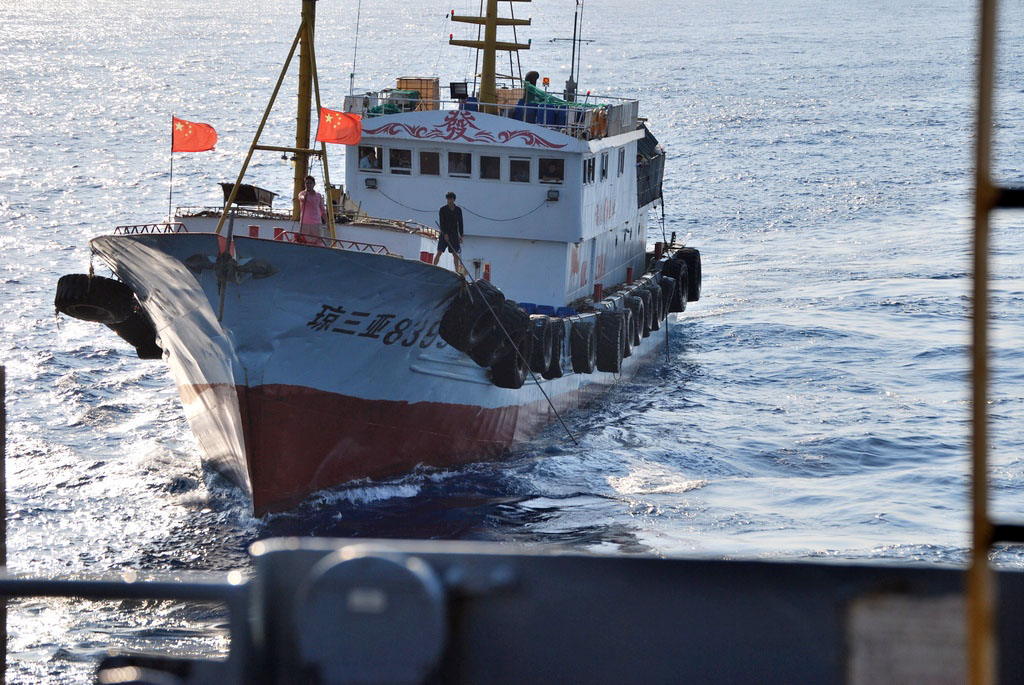
China’s War on the Law of the Sea Treaty and Implications for the U.S.
Yesterday, the world witnessed China’s rapidly modernizing military on the 70th anniversary of the end of the World War Two at Tiananmen Square. The revelation of DF-26 intermediate-range ballistic missiles, or “Guam Killer” in particular epitomized Beijing’s growing self-confidence. Yet, despite its evolving military hardware, the Chinese military’s modus operandi largely remains one of “salami slicing,” or posing incremental, oft-non-violent threats to overwhelm enemies. One victim of this strategy is the the maritime rule of law enshrined in the United Nations Conventions on the Law of the Sea (UNCLOS). Against this backdrop, U.S. ratification of UNCLOS would restore maritime law and order while strengthening Washington’s Asia strategy.
Three Warfares: Salami Slicing in Chinese Way
Beijing has an official doctrine for undermining UNCLOS. Unveiled by the People’s Liberation Army’s (PLA) General Political Department in 2003, Three Warfares (三战) consist of public opinion warfare (舆论战), psychological warfare (心理战), and legal warfare (法律战). They collectively aim to degrade enemy morale and are used well before the outbreak of physical hostilities. In short, the traditional distinction between war and peace becomes blurred, eluding countermeasures.
Legal warfare in particular plays a crucial role in Three Warfares. It seeks to exploit laws to China’s own advantage while constraining enemy freedom of movement through tendentious legal interpretations. The very instrumentality of such uses of law is an antithesis of rule of law and only confirms Beijing’s adherence to rule by law.
Moreover, legal warfare provides materials for waging public opinion warfare and psychological warfare. In other words, from Beijing’s perspective, UNCLOS is merely something to act on for additional attacks on enemy.
Three Warfares thus seek to deliver incremental assaults on enemy with each blow ultimately amounting to lethal damage. Therefore, the doctrine could potentially allow Beijing to prevail without firing a single bullet.
China’s War on the Maritime Rule of Law
Therefore, China views UNCLOS essentially as another weapon. From Beijing’s perspective, freedom of navigation is to be restricted in exclusive economic zones (EEZ), and this interpretation has already engendered a clash with the U.S. In 2009, Chinese vessels sought to intimidate a U.S. Navy surveillance ship, USNS Impeccable, when it was conducting maritime surveillance in China’s EEZ off the coast of Hainan Island. Although UNCLOS permits maritime surveillance in foreign EEZ, Beijing provided tendentious interpretations of the Convention by labelling the U.S. action in China’s EEZ as illegal because it had violated the country’s sovereignty. Applying its Three Warfare doctrine, China subsequently went on a furious propaganda campaign to spread its view in an attempt to discredit Washington’s position.
China’s war on the maritime rule of law has greater implications for the U.S. allies and partners. Indeed, most of these countries lack the wherewithal to counter China’s military coercions, often submitting to Beijing’s demands. For example, China forcibly placed an oil rig in EEZ off the coast of Paracel Islands that are disputed by Vietnam in 2014. In doing so, not only did Beijing challenge Article 56 of UNCLOS, but it also intimidated Vietnam into submission with superior military force, destroying a Vietnamese fishing vessel in the process.
Beijing also presents equally complex challenges against stronger U.S. allies and partners. The ongoing land reclamation projects in the South China Sea directly threaten neighboring countries, especially the Philippines, as well as freedom of navigation. If the land reclamation sites are accepted as islands under UNCLOS, they would suddenly expand China’s territorial seas as well as EEZ by hundreds of miles beyond the country’s mainland, potentially solidifying Beijing’s claim to its Nine-Dash Line. Moreover, given China’s tendentious interpretations of UNCLOS, such a scenario would place the world’s busiest sea lanes under Beijing’s de facto jurisdiction.
The U.S. and UNCLOS
Beijing’s defiance against the maritime rule of law is largely attributed to the pending U.S. ratification of UNCLOS. President Bill Clinton signed the Convention in 1994, but the Senate has yet to ratify it. This had led Washington to uphold the maritime rule of law only by interpreting customary international law, such as freedom of navigation. This has deprived the U.S. of credibility in its position vis-a-vis territorial disputes as well as its ability to support multilateral resolution of conflicts. As a result, Washington’s ability to build and maintain norms remains severely constrained.
U.S. non-ratification of UNCLOS also has global implications. EEZ constitute 40% of entire maritime space on earth. If China’s view of EEZ becomes accepted, it might shake the very foundation of UNCLOS. Indeed, during the 2014 oil rig incident, China’s intimidation tactics coerced Vietnam into essentially acquiescing in Beijing’s interpretation of EEZ. China’s salami-slicing strategy could eventually force other stronger neighbors, such as the Philippines, into submission to its views.
Prior to pomp and fanfare in Beijing yesterday, PLA Navy (PLAN) warships quietly appeared off the coast of Alaska during the U.S. president Barack Obama’s climate change tour. Given Beijing’s salami-slicing strategy in Asian EEZ, PLAN’s appearance yesterday near Alaska augurs ill for the U.S.-China maritime relations. Moreover, U.S. allies and partners increasingly find themselves unable to counter China’s ongoing war on UNCLOS. Before these issues exacerbate further, the U.S. Senate must ratify UNCLOS to strengthen the maritime rule of law as well as to boost Washington’s Asia rebalancing strategy.






Thanks for the clear article.
Now, How do we get Senate to ratify UNCLOS? What does it take to get key issues solved?
Ysende Seguin.